NoPoSplat
Surprisingly Simple 3D Gaussian Splats from Sparse Unposed Images (ICLR 2025)
No Pose, No Problem - Surprisingly Simple 3D Gaussian Splats from Sparse Unposed Images
Botao Ye, Sifei Liu, Haofei Xu, Xueting Li, Marc Pollefeys, Ming-Hsuan Yang, Songyou Peng
paper :
https://arxiv.org/abs/2410.24207
project website :
https://noposplat.github.io/
code :
https://github.com/cvg/NoPoSplat

Contribution
pose-free generalizable sparse-view 3D recon. model in canonical Gaussian space!
- model :
-
unposed(no extrinsic)sparse-viewimages로부터 3DGS를 통해 3D scene recon.하는 feed-forward network 제시 -
photometric loss만으로train 가능
(GT depth 사용 X, explicit matching loss 사용 X) - 본 논문은 intrinsic의 영향을 받는 image appearance에만 의존하여 recon.을 수행하므로
scale ambiguity문제 해결을 위해intrinsic embedding method사용
(intrinsic은 input으로 사용) - covariance, opacity, color를 예측하는 Gaussian Param. Head에서 fine texture detail 주기 위해
RGB shortcut사용
-
- downstream tasks :
- recon.된 3DGS를 이용하여 novel-view-synthesis 및 pose-estimation task 수행 가능
- 특히 limited input image overlap (sparse) 상황에서는 pose-required methods보다 더 좋은 성능
- 정확히 pose-estimation 수행하는 two-stage coarse-to-fine pipeline 제시
- generalize well to out-of-distribution data
- recon.된 3DGS를 이용하여 novel-view-synthesis 및 pose-estimation task 수행 가능
- Gaussian Space :
-
first input view의 local camera coordinate을canonical space로 고정하고 모든 input view의 3DGS들을 해당 space에서 directly 예측 - 기존에는 transform-then-fuse pipeline이었는데,
본 논문은 global coordinate으로의explicit transform 없이canonical space 내에서의 different views의 fusion 자체를 직접 network로 학습 - local coordinate에서 global coordinate으로 3DGS를 explicitly transform할 필요가 없으므로
explicitly transform하면서 생기는 per-frame Gaussians의 misalignment를 방지할 수 있고, extrinsic pose 없이도 (pose-free) 3D recon. 가능
-
Related Works
- SfM :
- bundle adjustment 등 최적화 과정을 거치는데,
off-the-shelf pose estimation method 사용하는 것 자체가 많은 연산을 필요로 하고 runtime 늘림 - 3D recon.에 only two frames만 input으로 사용하더라도
SfM을 통해 해당 two frames의 camera pose를 구하려면 many poses from dense videos 필요 (impractical) - textureless area (원형 호수 등) 또는 image가 sparse한 영역에서는 부정확한 pose 내놓음
- bundle adjustment 등 최적화 과정을 거치는데,
- Pose-Free Method :
- pose-estimation과 3D recon.을 single pipeline으로 통합하자! :
[1] ,[2] ,[3] - pose-estimation과 scene-recon.을 번갈아가며 수행하는 sequential process 에서 error가 쌓이기 때문에
SOTA novel-view-synthesis methods보다 성능 bad
- pose-estimation과 scene-recon.을 번갈아가며 수행하는 sequential process 에서 error가 쌓이기 때문에
- DUSt3R, MASt3R 계열
- pose-estimation과 3D recon.을 single pipeline으로 통합하자! :
- DUSt3R, MASt3R :
- 공통점 1)
pose-free method - 공통점 2)
directly predict in canonical space - 차이점 1)
DUSt3R, MASt3R는 transformer output이 3D pointmap (point cloud)인데,
NoPoSplat은 mean, covariance, opacity, color를 가진 3DGS (rasterization) 사용 - 차이점 2)
NoPoSplat은 DUSt3R, MASt3R 계열과 달리GT depth 필요 없고 photometric loss만으로훈련 가능
- 공통점 1)
- pixelSplat, MVSplat :
- 차이점 1) (아래 그림 참고)
pixelSplat, MVSplat은 먼저 intrinsic을 이용해 2D-to-3D로 unproject(lift)하여 each local-coordinate에서 3DGS를 예측한 뒤 extrinsic을 이용해 world-coordinate으로 transform한 뒤 fuse했는데,
NoPoSplat은 canonical space 내에서의 different views의 fusion 자체를 directly network로 학습하기 때문에global coordinate으로 transform할 필요가 없으므로이에 따른misalignment를 방지할 수 있고camera pose (extrinsic)도 필요 없음 - 차이점 2)
pixelSplat에선 epipolar constraint, MVSplat에선 cost volume이라는 geometry prior를 사용하였는데
image view overlap이 적을 때는 geometry prior가 정확하지 않음.
NoPoSplat은 (image overlap이 클 때 유리한)geometry prior들을 사용하지 않음
- 차이점 1) (아래 그림 참고)
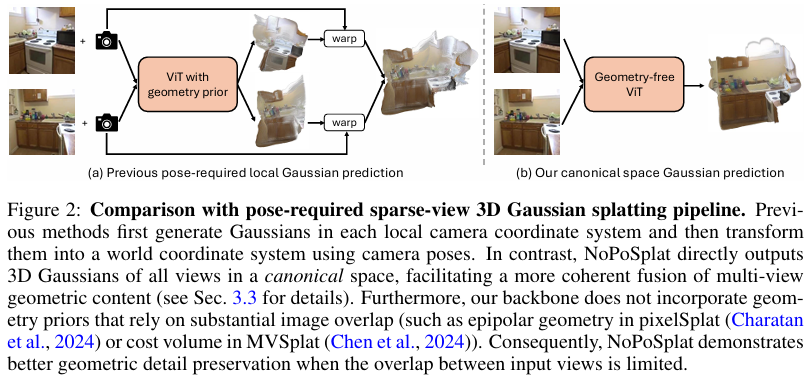
Method
Architecture

- I/O :
\(f_{\theta} : \left\{ (I^{v}, k^{v}) \right\}_{v=1}^{V} \mapsto \left\{ \bigcup (\mu_{j}^{v}, \alpha_{j}^{v}, r_{j}^{v}, s_{j}^{v}, c_{j}^{v}) \right\}_{j=1, \ldots, H \times W}^{v=1, \ldots, V}\)- input :
- sparse unposed multi-view images \(I\) (image 개수 \(V\))
- camera intrinsics \(k\) (available from modern devices
[4] )
- output :
- mean \(\mu \in R^{3}\), opacity \(\alpha \in R\), rotation \(r \in R^{4}\), scale \(s \in R^{3}\), SH \(c \in R^{k}\) (\(k\) degrees of freedom)
- input :
- Pipeline :
-
Encoder, Decoder:- 특히 input views끼리 content overlap이 적은 상황 (sparse) 에서는
epipolar constraint나 cost volume 같은 geometry prior가 없더라도
simple ViT 구조만으로도 좋은 성능 달성 가능 - RGB images를 image tokens로 patchify, flatten한 뒤
intrinsic token과 concatenate한 뒤
Encoder and Decoder에 feed-forward
- 특히 input views끼리 content overlap이 적은 상황 (sparse) 에서는
- Gaussian Parameter Prediction Head :
DPT 구조-
Gaussian Center Head:
Decoder feature 사용 -
Gaussian Param Head:
RGB image와 Decoder feature 사용-
RGB shortcut:
3D recon.에서 fine texture detail을 잡는 것이 중요하기 때문에 사용 - Decoder feature :
high-level semantic info.
-
-
-
Gaussian Space
- baseline:
Local-to-Global Gaussian Space- pixelSplat, MVSplat 등
- how :
먼저 each pixel의 depth를 network로 예측한 뒤
predicted depth와 intrinsic을 이용해 2D-to-3D로 unproject(lift)하여 each local-coordinate에서 3DGS 예측한 뒤
extrinsic을 이용해 world-coordinate으로 transform한 뒤
모든 transformed 3DGS들을 fuse - issue :
- local-coordinate에서 world-coordinate으로 transform할 때
accurate camera pose(extrinsic) 필요한데, 이는 input view가 sparse한 real-world 상황에서 얻기 어렵 - 특히 input view가 sparse할 때 또는 out-of-distribution data로 일반화할 때는
each transformed 3DGS들을 조화롭게 combine하는 게 어렵
- local-coordinate에서 world-coordinate으로 transform할 때
- NoPoSplat:
Canonical Gaussian Space- how :
first input view를 global referecne coordinate으로 고정한 뒤 (\([R | t] = [\boldsymbol I | \boldsymbol 0]\))
해당 coordinate 내에서 each input view \(v\) 마다 set \(\left\{ \mu_{j}^{v \rightarrow 1}, r_{j}^{v \rightarrow 1}, c_{j}^{v \rightarrow 1}, \alpha_{j}, s_{j} \right\}\) 을 예측
where view \(1\) : canonical Gaussian space - benefit :
- global coordinate으로 explicitly transform할 필요가 없으므로 camera pose (extrinsic) 필요 없음
- explicitly transform-then-fuse하는 게 아니라 fuse 자체를 network로 학습하는 것이기 때문에
조화로운 global representation 가능
- how :
Camera Intrinsic Embedding
- Camera Intrinsic Embedding :
- issue :
only appearance에만 의존하여 3D recon.을 수행함
scale ambiguity(scale misalignment) 문제 해결 필요!
필요한 geometric info.를 제공하기 위해!
intrinsic \(k = [f_{x}, f_{y}, c_{x}, c_{y}]\) - solve :
- Trial 1) Global Intrinsic Embedding by Addition :
intrinsic \(k\) 을 linear layer에 통과시킨 뒤 RGB image token에 add - Trial 2) Global Intrinsic Embedding by Concat :
intrinsic \(k\) 을 linear layer에 통과시킨 뒤 RGB image token에 concat - Trial 3) Pixel-wise (Dense) Intrinsic Embedding :
each pixel \(p_{j}\)에 대해 ray direction \(K^{-1} p_{j}\) 구한 뒤
SH 이용해서 high-dim. feature로 변환한 뒤
RGB image와 concat
- Trial 1) Global Intrinsic Embedding by Addition :
- issue :
Training and Inference
-
Loss :
only photometric loss
(linear comb. of MSE and LPIPS) - Relative Pose Estimation :
canonical space에 3DGS들이 있다는 전제 하에
two-stage coarse-to-fine pipeline- Coarse Stage :
Gaussian center에PnP algorithm with RANSAC(efficient as done in ms) 적용하여
initial rough pose estimate구하기 - Fine Stage :
3DGS param.을 freeze한 채
training에 사용했던photometric loss를 이용해
target view와 align되도록 roughtarget camera pose를 optimize(refine)- automatic diff.에서의 overhead를 줄이기 위해
camera Jacobian을 계산[5]
- automatic diff.에서의 overhead를 줄이기 위해
- Coarse Stage :
- Evaluation-Time Pose Alignment :
- unposed input images의 경우
scene은 다른데 rendered two images는 같을 수 있으므로
just two input views로 3D scene recon. 수행하는 건 사실 ambiguous - GT camera pose를 이용하는 other baseline들
[6] , 7과 비교하기 위해 (evaluation purpose)
pose-free methods[8] ,[9] 의 경우 target view에 대한 camera pose를 optimize한 뒤 비교에 사용
- unposed input images의 경우
Experiment
Implementation
- Experiment :
- Dataset :
- training :
RE10K (RealEstate10k) : indoor real estate
DL3DV : outdoor (camera motion pattern 더 다양) - zero-shot generalization :
ACID : nature scene by drone
DTU
ScanNet
ScanNet++
in-the-whild mobile phone capture
SORA-generated images
- training :
- camera overlap :
SOTA dense feature matching method[10] 로
input images’ camera overlap 정도를 측정하여
small (0.05%-0.3%), medium (0.3%-0.55%), large (0.55%-0.8%)로 나눔 - Baseline :
- pose-required novel-view-synthesis :
pixelNeRF, AttnRend, pixelSplat, MVSplat - pose-free novel-view-synthesis and relative pose estimation :
DUSt3R, MASt3R, Splatt3R, CoPoNeRF, RoMa
- pose-required novel-view-synthesis :
- Implementation :
encoder, decoder, Gaussian center head는 MASt3R의 weights로 initialize하고
(사실 scratch부터 training해도 성능 비슷하긴 함)
Gaussian param head는 randomly initialize
- Dataset :
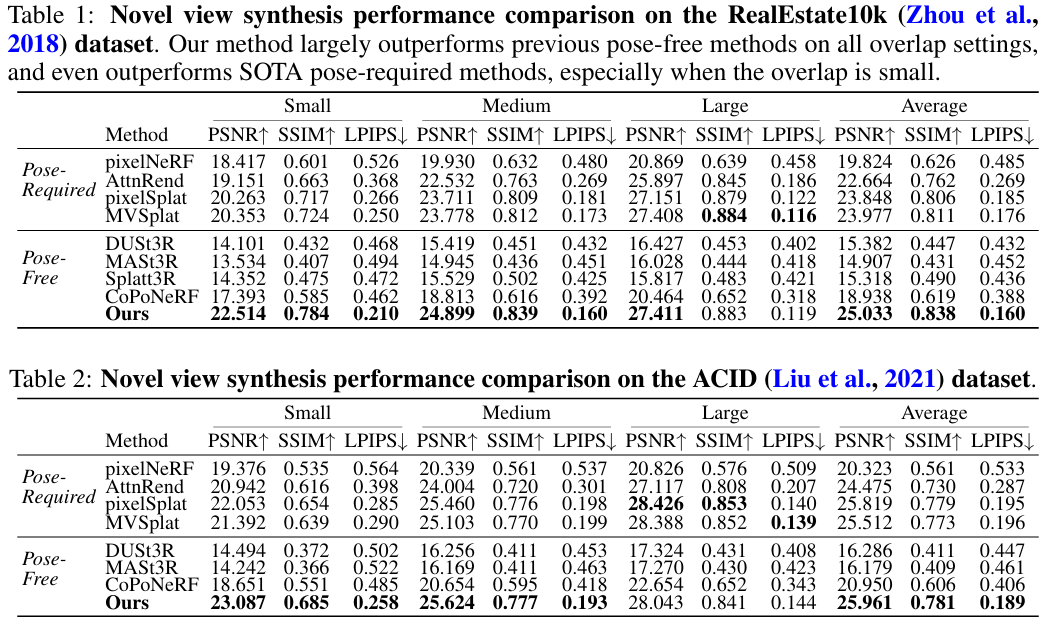
Result
- Novel View Synthesis :
- SOTA pose-free (DUSt3R, MASt3R, Splatt3R) :
- DUSt3R 계열은
per-pixel depth loss에 의존하기 때문에 each views를fuse하는 게 어렵
그래서 대부분 상황에서 NoPoSplat이 훨씬 더 좋음
- DUSt3R 계열은
- SOTA pose-required (pixelSplat, MVSplat) :
- pixelSplat, MVSplat은
input view overlap이 작을 때 부정확한 geometry prior(epipolar constraint, cost volume)을 사용하기 때문에
image view overlap이 작은 상황에서는 NoPoSplat이 더 좋음 - pixelSplat, MVSplat은
transform-then-fuse strategy를 사용하는데misalignment로 부정확할 수 있기 때문에
canonical space에서 directly 예측하는 NoPoSplat이 더 좋을 수 있음
- pixelSplat, MVSplat은
- SOTA pose-free (DUSt3R, MASt3R, Splatt3R) :
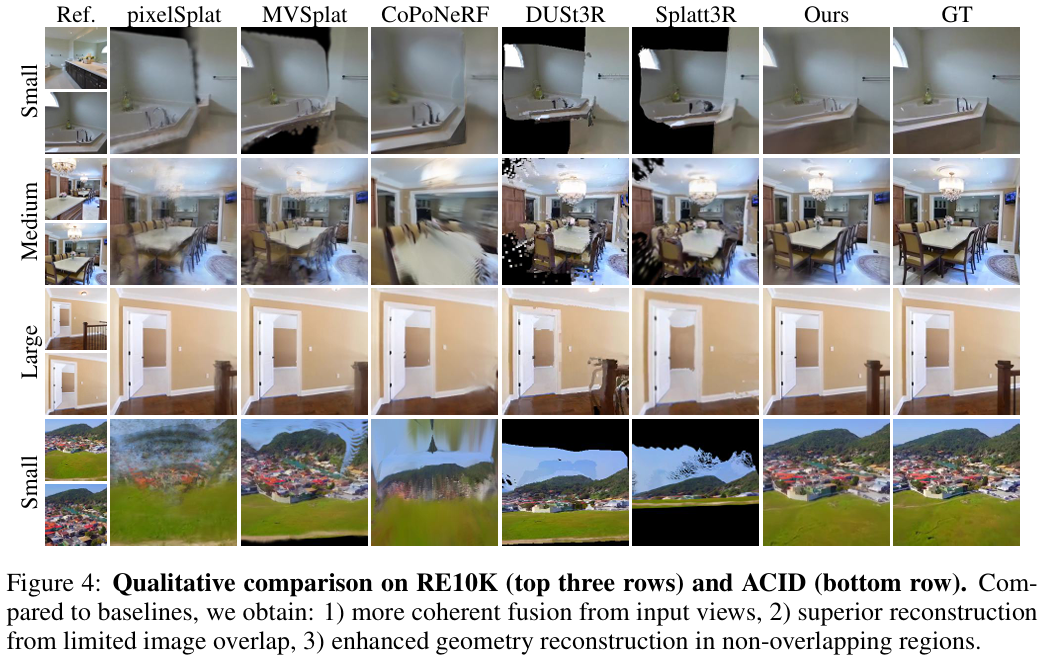

- Relative Pose Estimation :

- Geometry Reconstruction :
- SOTA pose-required (pixelSplat, MVSplat) :
- pixelSplat, MVSplat은 explicitly transform-then-fuse하는 과정에서 두 input images의 경계 영역에서 misalignment (아래 그림에서 파란색 화살표로 표기) 가 있고,
input views’ overlap이 적을 때는 geometry prior가 부정확해서 distortion (아래 그림에서 분홍색 화살표로 표기) 있는데,
NoPoSplat은 canonical space에서 directly 예측하므로 해결
- pixelSplat, MVSplat은 explicitly transform-then-fuse하는 과정에서 두 input images의 경계 영역에서 misalignment (아래 그림에서 파란색 화살표로 표기) 가 있고,
- SOTA pose-required (pixelSplat, MVSplat) :
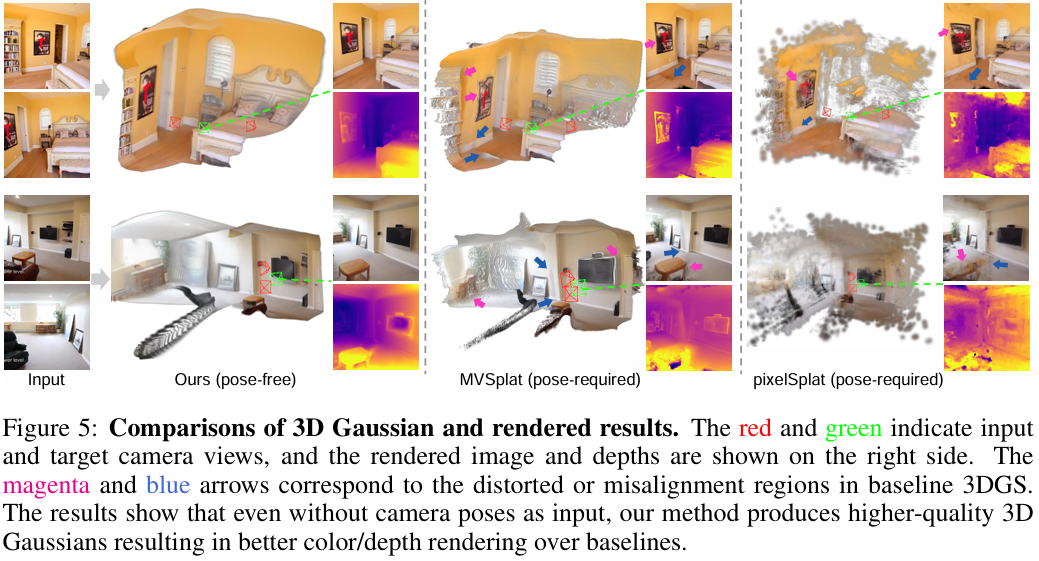
- Cross-Dataset Generalization :
NoPoSplat은 geometry prior를 사용하지 않으므로 다양한 scene type에 adapt 가능
심지어 ScanNet++로의 zero-shot generalization에 대해 RE10K로 훈련시킨 NoPoSplat과 ScanNet++로 훈련시킨 pose-required Splatt3R을 비교했을 때 NoPoSplat이 더 좋음!
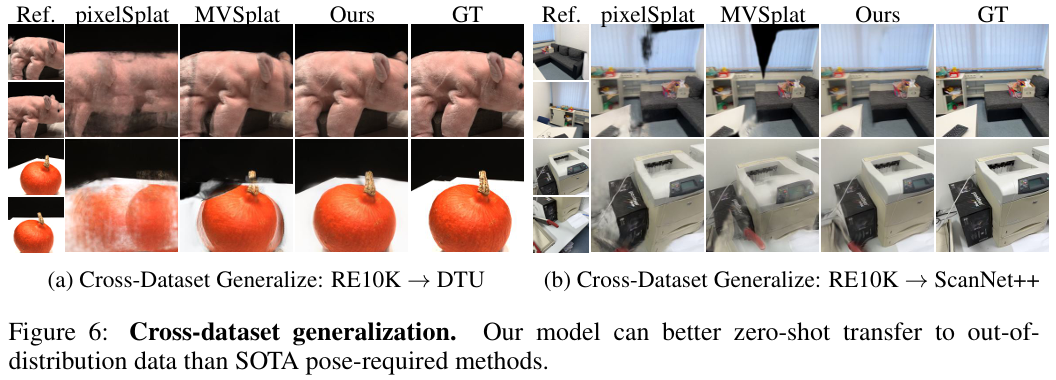
- Model Efficiency :
NoPoSplat은 0.015초만에 (66 FPS) 3DGS 예측 가능
(additional geometry prior 안 쓰니까 speed 빠름!)

- In-the-Wild Unposed Images :
3D Generation task에 적용 가능!
먼저 text/image to multi-image/video model 이용해서 sparse scene-level multi-view images 얻은 뒤
Ours (NoPoSplat) 이용해서 3D model 얻음
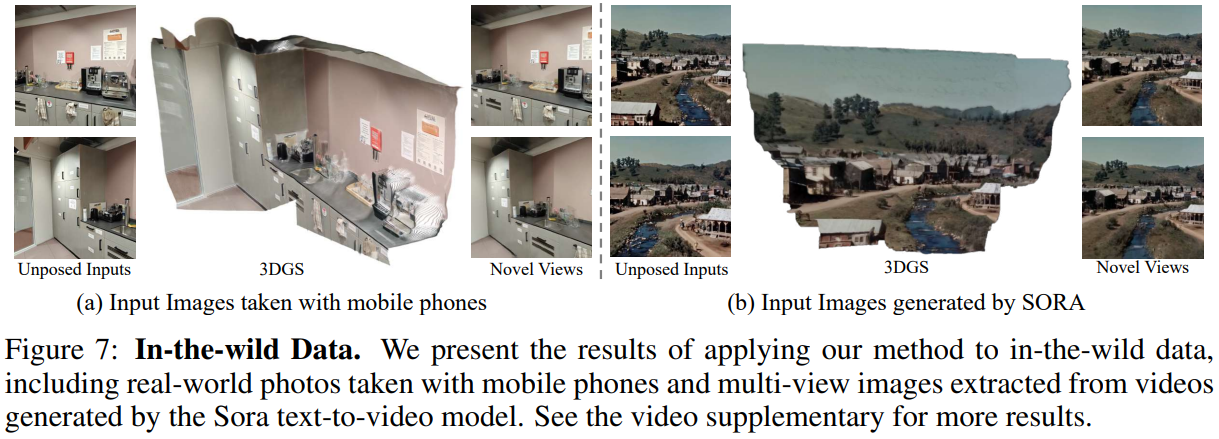
Ablation Study
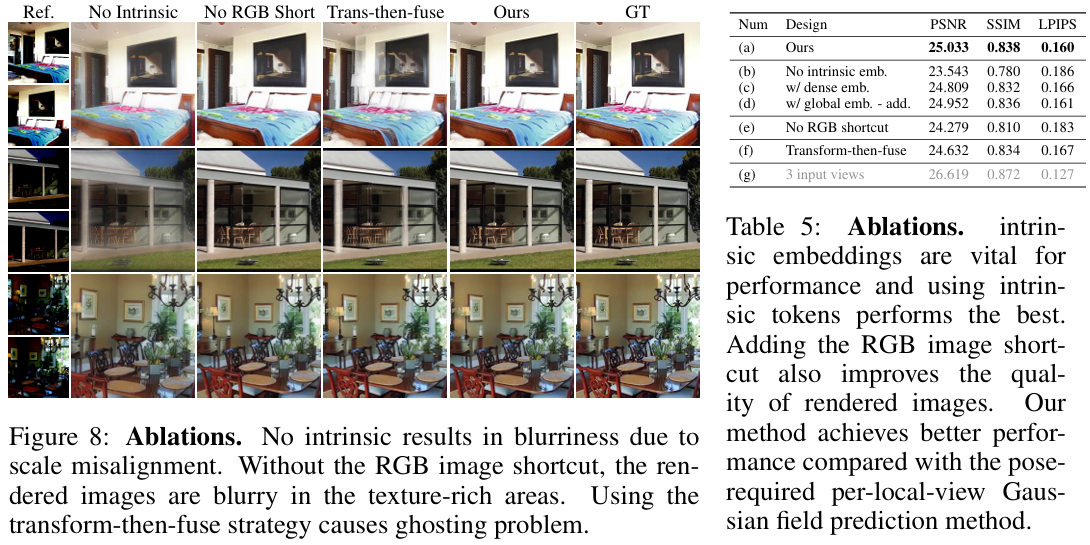
- Ablation Study :
-
Output Canonical Gaussian Space:
transform-then-fuse pipeline of pose-required methods hasghosting artifacts -
Camera Intrinsic Embedding:
no intrinsic leads toblurryresults due toscale ambiguity
실험적으로 intrinsic token concat. 방식이 best -
RGB Shortcut:
no RGB Shortcut leads toblurryresults in texture-rich areas
(위 그림의 quilt in row 1 and chair in row 3) -
3 Input Viewsinstead of 2 :
baselines과의 공평한 비교를 위해 NoPoSplat은 two input-views setting을 사용했는데
three input-views를 사용할 경우 성능이 훨씬 좋아졌음!
-
Conclusion
-
Future Work :
NoPoSplat은 static scene에만 적용했는데, dynamic scene에 NoPoSplat의 pipeline을 확장 적용! -
Limitation :
-
camera intrinsic은 known이라는 걸 가정! - feed-forward model은
non-generative하므로unseen region에는 대응 못 함 -
static scene에 적용
-
Question
-
Q1 :
사실 NoPoSplat은 camera pose 이용한 global coordinate으로의 explicit transform이나 geometry prior (epopiolar constraint, cost volume 등)나 GT depth 없이
오로지 implicit network의 학습에 의존하여 scene recon. 능력을 학습하겠다는 건데
photometric loss만으로도 잘 학습이 되나? two input images 경계면의 smoothness 등 추가 regularization loss 추가해주는 게 낫지 않음? -
A1 :
TBD -
Q2 :
photometric loss에만 의존하기 때문에 ViT semantic info. 말고도 more info. 주기 위해 intrinsic과 RGB shortcut을 사용하는데
둘 말고 또 추가하면 좋은 거 있을까? -
A2 :
TBD